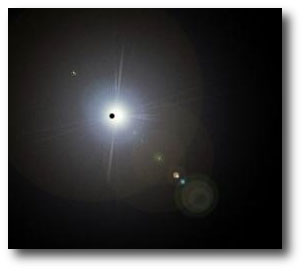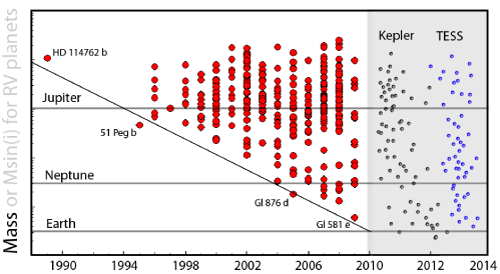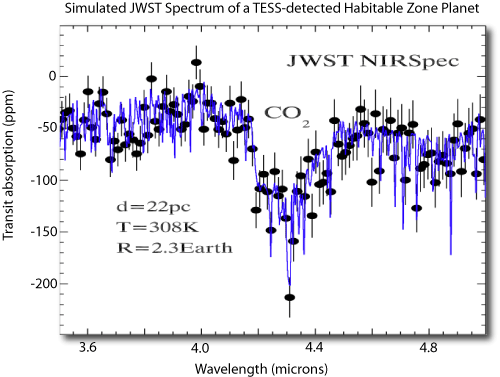
Georges-Louis Leclerc, Comte de Buffon is well known to givers of planet talks as one of the original proponents of physical cosmogony. Further fame accrues to his long-distance tangle with Thomas Jefferson over the size and the valor of the North American fauna. Buffon also made interesting contributions to probability theory, including the very sensible proposition that 1/10,000th is the smallest practical probability [source].
I think it’s reasonable to apply Buffon’s rule of thumb in discussing scenarios for the detection of the first potentially habitable extrasolar planet. If a scenario has a less than 10^-4 chance of unfolding, then it’s not worth expounding on in a web log post.
There’s no getting around the fact that the extrasolar planets are a long way away. Traveling at just under the speed of light, one reaches Alpha Cen Bb during Obama’s second term, and Gliese 581c, the extrasolar planet with the highest current value on the habitable planet valuation scale, lies 20 light years away. For practically-minded types such as myself, it’s depressing to think of the realistic prospects (or lack thereof) of actually reaching these worlds in a lifetime. And why spend trillions of dollars to visit Gliese 581 c when Venus is basically right next door?
It’s imperative to know the addresses of the nearest potentially habitable planets, though, and this is a goal that should be reached within roughly a decade or two. Barring a strike with some household name like Alpha Centauri or Tau Ceti, it’s a reasonable bet that the closest million-dollar world is orbiting a red dwarf.
The general suitability of red dwarf planets is often viewed with suspicion. Atmosphere-eroding flares, tidally spin-synchronized orbits, and gloomy formation-by-accretion scenarios provide ample material for space-age Jeremiahs. But first things first. With what frequency are Earth-sized T_eff~300K planets actually to be found in orbit around red dwarfs?
If planets form from analogs of the so-called Minimum Mass Solar Nebula, then the answer is quite well established: almost never.
If, however, instead of scaling down from the Minimum Mass Solar Nebula, we scale up from the proto-Jovian, proto-Saturnian and proto-Uranian disks, then the prospects are quite good. Ryan Montgomery and I have an Icarus preprint out which looks in detail at the consequences of an optimistic planet formation scenario for red dwarfs. Perhaps the most redeeming aspect of our theory is that it will be put to the test over the next decade. If hefty terrestrial planets are common around red dwarfs, then the currently operating ground-based MEarth survey will have an excellent chance of finding several examples of million-dollar wolds during the next several years, and the forthcoming TESS Mission will quite literally clean up.
In the spirit of Buffon, though, for the exact specifics of scenario three, it’s fun to probe right down to the limit of practical odds. Consider: An Earth orbiting a star at the bottom of the Main Sequence produces a transit depth that can approach 1%. If Barnard’s Star harbors an optimally sized and placed planet, then its value is a cool 400 million dollars. Such a planet would have an orbital period of about 13 days, and an a-priori transit probability of roughly 2%. I estimate a 1% chance that such a planet actually exists, which leads to a 1 in 5000 chance that it’s sitting there waiting for a skilled small-telescope observer to haul it in. In expectation, it’s worth $87,200, more than the equivalent of a Keck night, to monitor Barnard’s star at several milli-magnitude precision for a full-phase 13 days. That’s $280 dollars per hour. There are few better uses to which a high-quality amateur telescope could be put during those warm and clear early-summer nights.





